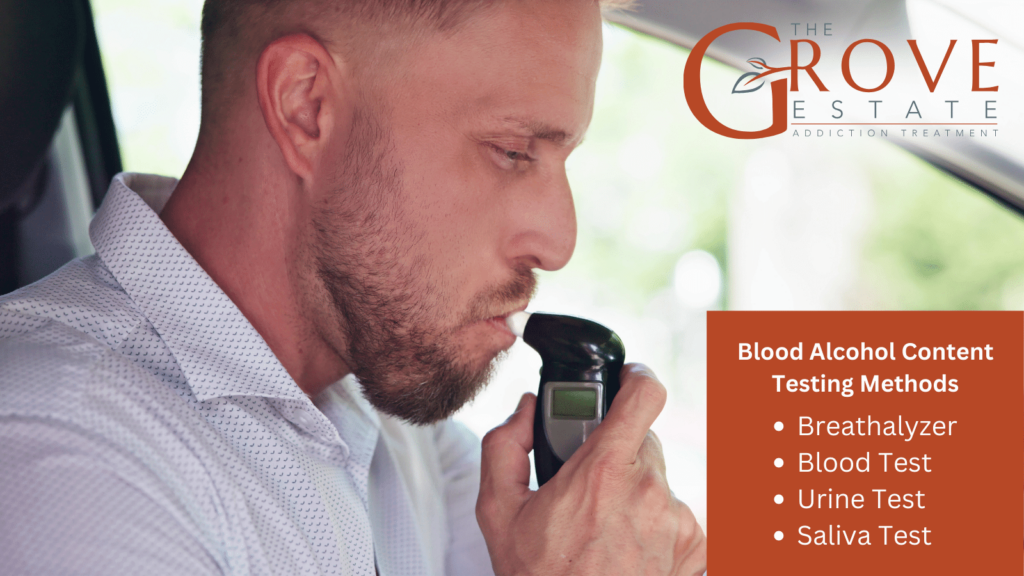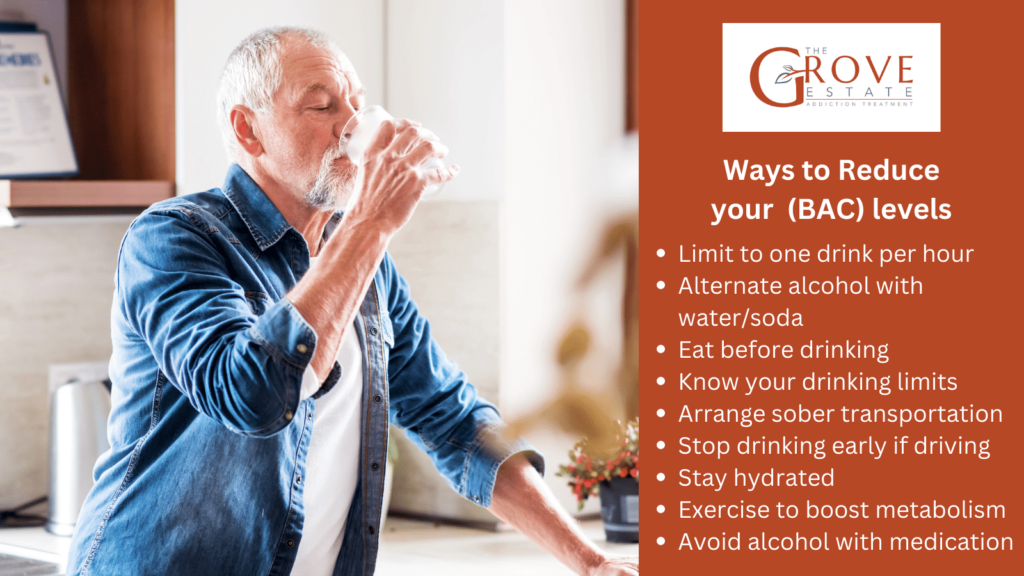Blood Alcohol Content (BAC) is a critical measure used to determine the level of alcohol in a person’s bloodstream. Understanding BAC levels is essential for assessing impairment and making informed decisions regarding alcohol consumption.
According to data from the National Highway Traffic Safety Administration (NHTSA), a BAC of 0.08% or higher is the legal limit for driving under the influence (DUI) in the United States. However, even lower BAC levels can lead to impaired cognitive and motor functions, affecting judgment, coordination, and reaction time. Understanding BAC levels is essential not only for legal purposes but also for making responsible decisions regarding alcohol consumption and ensuring public safety on the roads.

What is Blood Alcohol Content (BAC)?
Blood Alcohol Content (BAC) is a measure of the concentration of alcohol in a person’s bloodstream, expressed as a percentage. It indicates the amount of alcohol present per 100 milliliters of blood.
BAC is typically measured using a breathalyzer or through blood or urine tests. It is an essential metric for assessing an individual’s level of intoxication and impairment, particularly concerning activities like driving. Legal limits for BAC levels vary by jurisdiction, with higher BAC levels associated with increased risks of impaired cognitive and motor functions.
How Is BAC Calculated?
BAC is calculated based on several factors, including the amount of alcohol consumed, body weight, gender, metabolism, and the timeframe of consumption. Alcohol is absorbed into the bloodstream through the stomach and small intestine and then metabolized by the liver at a relatively constant rate.
Blood alcohol content calculators use mathematical formulas to estimate BAC levels based on input variables such as the number of drinks consumed, body weight, and time since drinking. While these calculators provide approximate BAC levels, actual BAC can vary based on individual differences in alcohol metabolism and other factors.
The formula commonly used to estimate Blood Alcohol Content (BAC) is:
BAC=Body weight in grams/(Alcohol consumed in grams × 0.789) × 100 − (Metabolic rate × Hours since drinking)
What Factors Influence BAC Levels?
The factors that influence Blood Alcohol Content (BAC) levels are important for individuals to make informed decisions about their alcohol consumption and potential impairment. Several variables contribute to variations in BAC levels:
- Body weight: Heavier individuals typically metabolize alcohol more efficiently.
- Gender: Gender differences can influence BAC levels, with women often experiencing higher BAC levels for the same amount of alcohol consumed.
- Food intake: Consuming food can slow down alcohol absorption and reduce BAC levels.
- Alcohol absorption rates: The type of beverage and its concentration affect how quickly alcohol is absorbed into the bloodstream.
- Metabolism: The liver processes alcohol at a relatively constant rate, typically metabolizing about one standard drink per hour.
This comprehensive guide explores these influential factors, shedding light on how they impact BAC levels and the implications for alcohol-related behavior and safety.
What Do Different BAC Levels Indicate?
Blood Alcohol Content (BAC) levels help when assessing alcohol’s effects and legal implications. Here’s a simplified breakdown:
- BAC Below 0.02%: Minimal impairment, generally safe for most.
- BAC Between 0.02% to 0.05%: Slight impairment, lowered inhibitions, and reaction time.
- BAC Between 0.05% to 0.08%: Moderate impairment, affecting coordination and judgment. Legal limit for driving in many countries.
- BAC Between 0.08% to 0.15%: Significant impairment, including slurred speech and reduced motor skills.
- BAC Above 0.15%: Severe impairment, high risk of blackouts and alcohol poisoning.
Exceeding legal BAC limits, especially while driving, can result in fines, license suspension, and legal charges.
How to Estimate Your BAC
Using a BAC calculator can help estimate your Blood Alcohol Content (BAC) based on factors like the number of drinks consumed, body weight, and time since drinking. Here are ways to use a BAC calculator and understand its limitations:
- Input Relevant Information: Enter the number and type of drinks consumed, your body weight, and the duration of drinking into the BAC calculator.
- Calculate BAC: The calculator will provide an estimated BAC level based on the information provided. This estimate can help gauge your level of intoxication.
- Consider Limitations: It’s important to note that BAC calculators provide rough estimates and may not account for individual variations in alcohol metabolism, tolerance, or other factors that can affect BAC levels.
- Use as a Guide: While BAC calculators can offer useful insights, they should not be relied upon as precise measurements of BAC. Actual BAC levels can vary based on various factors, and the calculator’s estimate should be used as a guide rather than an exact measurement.
The Legal Perspective on BAC
- Legal BAC Limits: Legal Blood Alcohol Content (BAC) limits for driving vary by region. In many countries, including the United States, the legal limit is set at 0.08%. However, some regions have lower limits, such as 0.05% or even zero-tolerance policies for certain drivers.
- Consequences of Exceeding Limits: Exceeding legal BAC limits can result in severe consequences, including:
- Fines and penalties
- License suspension or revocation
- Legal charges, such as driving under the influence (DUI) or driving while intoxicated (DWI)
- Increased insurance rates
- Potential harm to oneself and others due to impaired driving

What are the Blood Alcohol Content Testing Methods?
- Breathalyzer: A commonly used method that measures alcohol levels in exhaled breath. It estimates BAC based on the alcohol content in the breath sample.
- Blood Test: Considered the most accurate method, a blood test directly measures the alcohol concentration in the bloodstream. It provides a precise BAC reading.
- Urine Test: Less common and generally less accurate than breath or blood tests. It measures alcohol metabolites in urine to estimate BAC levels.
- Saliva Test: Another method that detects alcohol in saliva samples. It provides a quick assessment of recent alcohol consumption but may not be as accurate as blood or breath tests.
- Reliability: Blood tests are the most reliable for accurate BAC measurements. Breathalyzer tests are widely used and generally reliable if properly calibrated and administered. Urine and saliva tests may have lower accuracy levels and are less commonly used for BAC testing.
How Long Does Alcohol Stay in Your System?
Alcohol can typically stay in your system for several hours to days, depending on factors like your Blood Alcohol Content (BAC) levels, body weight, metabolism, hydration levels, and the amount of alcohol consumed. The amount of alcohol consumed and the type of alcoholic beverage can impact how long alcohol remains in your system. Drinks with higher alcohol content, such as spirits, may take longer to metabolize compared to lower-alcohol beverages like beer or wine. Additionally, individual differences in liver function and enzyme activity can affect alcohol metabolism rates, leading to variations in how long alcohol can be detected in your system.
What is Alcohol’s Impact on Health at Different BAC Levels?
- Short-term Health Risks: At lower BAC levels, individuals may experience mild effects such as relaxation, lowered inhibitions, and impaired judgment. As BAC levels increase, risks escalate to include slurred speech, impaired coordination, and increased accident susceptibility.
- Long-term Health Risks: Chronic alcohol use, regardless of BAC levels, can lead to serious health consequences such as liver disease, heart problems, digestive issues, and increased risk of certain cancers. Prolonged alcohol misuse can also contribute to mental health disorders like depression and anxiety.
- Recognizing Alcohol Poisoning: Severe intoxication at high BAC levels can lead to alcohol poisoning, characterized by symptoms such as confusion, vomiting, seizures, slow or irregular breathing, and unconsciousness. Immediate medical attention is necessary to prevent life-threatening complications associated with alcohol poisoning.

How Can One Effectively Manage and Reduce Their Blood Alcohol Content (BAC)?
To manage and reduce your Blood Alcohol Content (BAC) levels, practice safe drinking habits such as pacing yourself with no more than one standard drink per hour, alternating alcoholic drinks with water or soda, eating food to slow alcohol absorption, and knowing your limits. Plan for alternative transportation or designate a sober driver if needed. To reduce BAC levels responsibly, stop drinking well before driving or operating machinery, stay hydrated with non-alcoholic beverages, engage in physical activity to boost metabolism, and avoid mixing alcohol with medications or other substances that can enhance its effects. These strategies promote safer alcohol consumption and minimize the risk of intoxication-related issues.
How long does it take for BAC to rise after drinking alcohol?
BAC can start to rise within minutes of consuming alcohol, and it typically peaks about 30 to 90 minutes after drinking.
Can BAC vary between individuals who drink the same amount of alcohol?
Yes, BAC can vary significantly between individuals due to differences in body size, metabolism, and other factors.
What are the risks of high BAC levels?
High BAC levels can lead to severe impairment, loss of consciousness, alcohol poisoning, and even death.
What role does metabolism play in determining BAC levels?
Metabolism significantly influences Blood Alcohol Content (BAC) levels by affecting the rate at which alcohol is processed and eliminated from the body. Individual metabolic rates can vary greatly, influenced by factors such as age, gender, liver health, and genetic predispositions. The liver is primarily responsible for metabolizing alcohol, typically processing one standard drink per hour. However, variations in liver efficiency and enzyme activity among individuals mean that some people may metabolize alcohol more quickly or slowly than others, leading to differences in BAC levels after consuming the same amount of alcohol.
For individuals concerned about their alcohol consumption and its potential impact on health, including the risk of alcohol nerve damage, understanding the role of metabolism in determining BAC can be crucial. Such knowledge can help gauge how alcohol might affect them personally and inform safer drinking practices.
Can hydration affect BAC and its effects on the body?
Yes, hydration can affect Blood Alcohol Content (BAC) and its effects on the body. Adequate hydration can dilute alcohol concentration in the blood, potentially leading to a lower BAC level. Moreover, being well-hydrated can help mitigate some negative effects of alcohol, such as hangovers, which are partly caused by dehydration. However, it’s important to note that while staying hydrated may influence how alcohol affects the body, it does not significantly change how quickly the liver metabolizes alcohol. Therefore, drinking water alongside alcoholic beverages can be beneficial for overall health but won’t drastically alter BAC levels.
In the context of understanding and managing alcohol consumption, it’s also valuable to consider the broader implications of drinking, such as its impact on family dynamics and the importance of family integration in recovery and support processes. Addressing alcohol consumption holistically, including physiological and relational aspects, can lead to more effective management and healthier outcomes.

Share This Post



